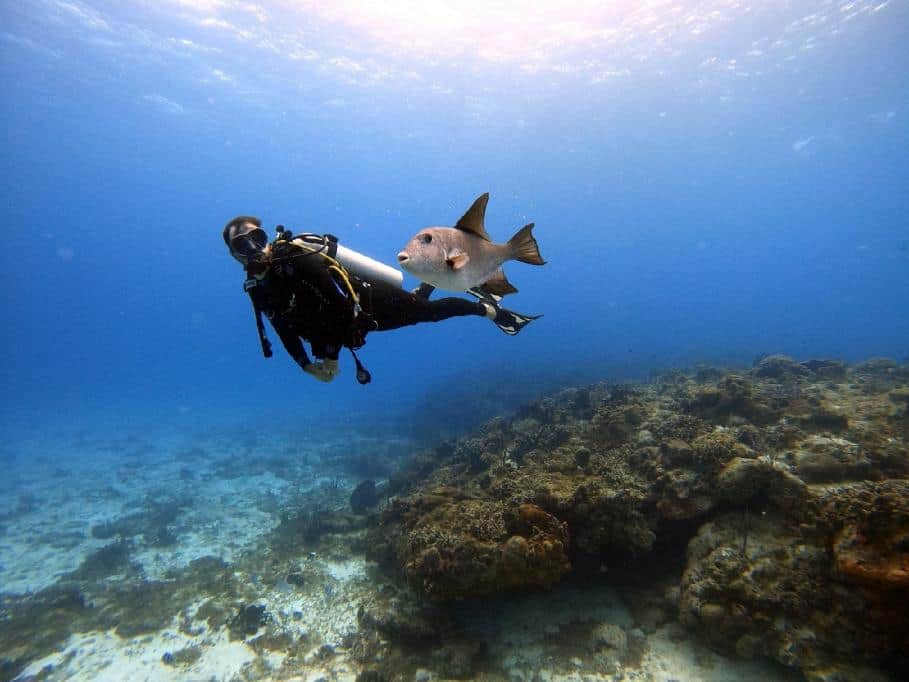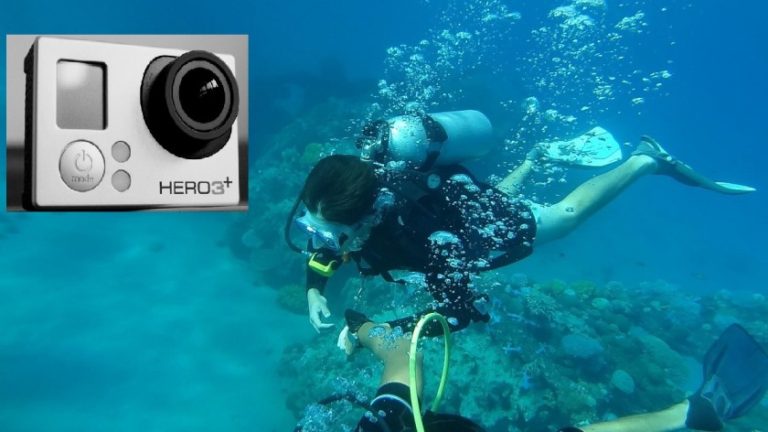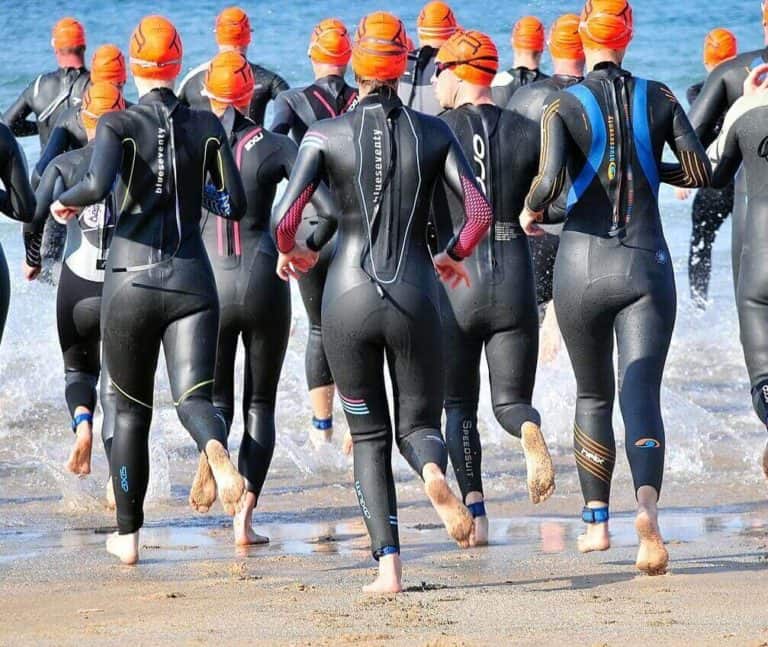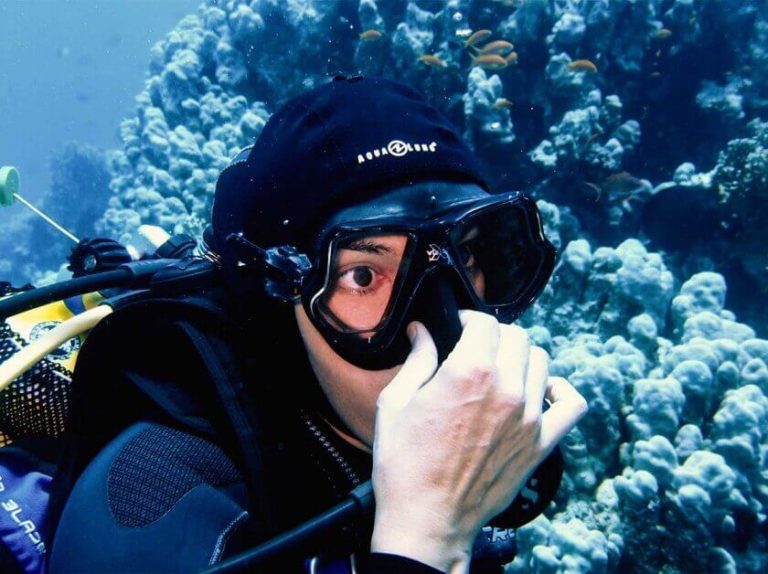Best Fins for Strong Currents
Maybe you just planned a trip to one of the top diving destinations in the world. Then later learned that it is among the spots known to have strong currents any diver can experience. As a beginner do you cancel the trip or prepare for the diving conditions?
As a beginner, it’s quite easy to feel intimidated or scared of strong currents. No need to worry, with the right training and gear any beginner can make it out of a strong current as well as advanced divers can. One way a diver can prepare is by getting fins best suited for diving in currents and learning the correct kick style and other diving techniques.
The best fins for strong currents are stiffer, shorter, favor frog kicking, and have powerful propulsion. With these features, the diver can easily swim against a current without using up a lot of energy or cramping their feet from vigorous kicking. A good example of fins with these features includes the ScubaPro Jet Fins and Apeks+RK3.
This however doesn’t mean that a diver using other types of fins can’t survive a strong current. As mentioned before, the techniques and diving skills used will play a bigger part when dealing with currents.
In case a diver is using fins that favor flatter kicks more, they can choose to stay behind a reef, wreck, or at the sea bed where the current isn’t very strong. If this is not possible, then the diver can choose to do a drift dive.
In the next few paragraphs, we’ll look into the best fins for strong currents, and how to dive safely in a strong current. I’ll also mention diving accessories necessary for strong current diving.
Let’s dive into it!!
Just schooling around! #palau #scubadiving #scuba #diving #marinelife #ocean #getoutside #wunderlust #aqua #fish #… pic.twitter.com/89sZ317ZTo
— Steven West (@mecan) October 4, 2016
Recommended Fins for Strong Currents
Now let’s look at the best fins suited for diving in strong currents.
Apeks+RK3
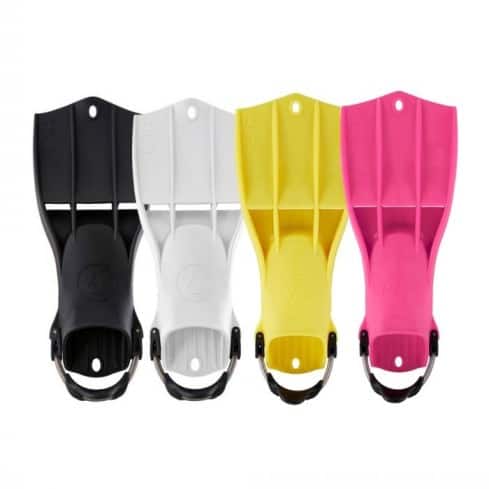
These fins are popular and highly rated among professional and military divers. The fins have been used for so many years by the listed groups and continue to gain popularity among all other scuba divers.
The fins have a vented design, made from rubber making them very long-lasting. The short and wide blade design allows powerful forward thrusts and also improves maneuverability.
When diving in caves, and wrecks with very harsh conditions, the divers can move around easily without worrying about the blade length.
The foot pocket design has been improved for comfort compared to previous models.
As an open-heel type of fin, the spring straps allow adjustability depending on the foot size and the diving boot or socks paired with the fin. Divers can comfortably wear 3 mm dive boots with the fin.
Dives with wide feet will love this fin as the foot pocket is designed to accommodate even the largest and widest feet.
The short, wide, and stiff blades favor frog kicks making them ideal for strong currents. The vented blade allows some water to flow through easing the pressure on the foot as the diver kicks.
More reasons to love these fins include, that they are light-weight and compact ideal combination for travel. When traveling to one of the dive destinations known to have strong currents, these are the fins to go for.
Available in black and other bright colors as well.
If you ever wondered how military divers feel when scuba diving, this is a great start. Dive in the same fins used and trusted by the military for decades.
Scubapro Jet Fins
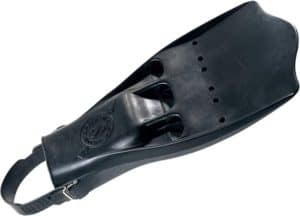
Another OG brand among scuba divers. These fins are among the oldest type of fins used in scuba diving. Despite the many years they’ve been around, they are still rated as some of the best fins for diving in harsh conditions such as strong currents.
Made from rubber just like the Apeks RK3, these fins will serve you for a very long time.
The fin has a vented design to help reduce drag during the recovery kicks. Similarly, the vents help enhance thrust when making a down stroke.
Great fins for frog kicking, useful in strong currents, cave, and wreck dives as well as any other harsh diving conditions.
The spring strap allows easy sliding in and sliding off the fins.
The foot pocket however may cause some challenges, especially for a beginner. The design of the foot pocket requires the diver to apply a lot of force when kicking.
A diver who isn’t used to this type of fin design or hasn’t mastered frog kicking can end up experiencing muscle cramping on their feet and legs. Such a diver will also get tired easily using these fins.
Seasoned divers however have no trouble using them and many do actually love them over other fins they may own for all kinds of diving.
The fins come in different colors and sizes.
Divers with wide feet will love the foot pocket as it can accommodate wide feet without causing cramping or discomfort around the strap area.
Read More: Best Scuba Fins for Wide Feet
Mares Avanti Quattro Fins
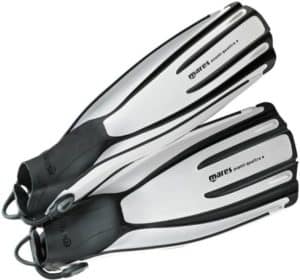
Mares Avanti Quattro Fins are ideal for almost all kicking styles and have a powerful thrust useful when diving in harsh conditions.
The fins are not vented. The glide and maneuverability in these fins are smooth, they are very easy to control and offer great speed.
The primary material used is thermoplastic rubber meaning they are not very rigid or very stiff. They are the ideal flexibility required to maximize all the features such as powerful thrust, maneuverability, and speed.
Available in many colors and sizes and are ideal for wide feet as well. The anatomical foot pocket makes them comfortable to wear with thick dive boots or diving socks.
Feature a bungee strap for easy access and take-off.
The only downside to these fins is that they are quite bulky and large. If you are traveling with them, you will need a large dive bag to securely carry the fins and other diving gear and accessories.
IST Rubber Rocket Scuba Diver Fins
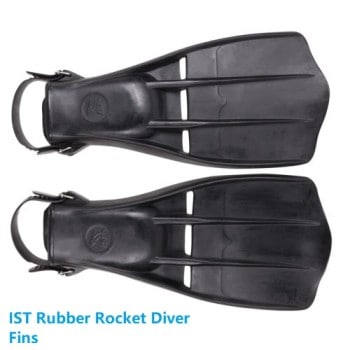
Another great pair of fins. Made from rubber the IST Rubber Rocket Scuba Diver Fins are very durable and strong.
These fins are also popular among military divers and Special Ops. The vented blade design helps in thrusting divers when in harsh environments such as strong currents.
A short and wide blade makes the fins ideal for frog kicking. A diver experiences reduced drags during upstroke while enjoying powerful forward thrusts. In addition, the blade has a curved design which enhances propulsion.
The overall design of the fins enhances maneuverability when diving in harsh conditions and in confined areas such as caves and in wreck diving.
Great fins for wide feet and can comfortably be won with diving booties or socks.
The compact design makes them ideal for traveling as they won’t take up much space in your dive bag.
Dive Sites Known To Have the Strongest Currents
If planning a trip to Cozumel, Cancun, Palau, and Indonesia just to mention a few, be prepared to encounter some strong currents during your dive.
Currents are caused by different factors such as winds, tides, gravity, temperature, and water density. Depending on these factors water in the ocean can change the direction and speed at which it flows causing the currents.
It’s important to note that, surface currents are different from underwater currents. In some cases, you can experience currents on the surface but none is underwater, and vice versa.
Before starting a dive, especially in the spots known to have very strong currents, it’s important to check for currents. This will help your dive instructor decide whether it’s safe to proceed or abort the dive.
Some techniques used to access the current situation include dropping a flotation device or a coconut in the water and observing how it flows. If it flows very fast in one direction this shows the direction of the surface currents and how strong it is.
To check for underwater currents, the dive instructor can snorkel in the area and access the situation beneath. These are some of the signs that can indicate a strong underwater current.
- A school of fish and other marine life moving in one direction
- If the fish are barely swimming and just going with the water
- Algae, soft corals, and other marine plants are all bent in the same direction
- If there are other divers, observe the flow and direction of bubbles. If the bubbles seem to flow rapidly towards their back then the currents could be very strong
Once the instructor has accessed the situation underwater, they can choose to abort the dive or wait for the current to go down.
If the currents are mild and safe to dive in, dives use a line system to descend into the water. This prevents divers from getting swept away as soon as they plunge into the ocean. The line from the dive boat acts as a guide when ascending after the dive.
How to Dive Safely Into Currents
If you haven’t already encountered strong currents during a dive, then be sure to expect them along the way in your diving career.
Divers often find themselves caught up in mild or strong currents. In such a scenario, the diver can do a drift dive, dive against the current, anchor behind a reef, a wreck, or onto the sea bed to avoid drifting away from their team.
Sometimes the currents can be too overpowering sweeping the divers away from their buddies. In this case, it’s important for the diver to be prepared with the correct accessories. Such as flare, whistle, signaling mirror, or DSMB. These accessories will help your boat spot you and come pick you up after drifting away.
When the currents are mild, divers can easily dive against the current and enjoy spectacular views. Having the correct fins helps in easy movements while using minimal energy.
While fin types are designed to facilitate different types of kick styles and propulsion, fins don’t really matter if you lack effective skills in using them.
The frog kick is very powerful and will thrust the diver forward with little effort. This makes it a powerful technique especially when diving against currents. The powerful thrusts counter the current and avoid dragging back with the current flow.
Divers don’t always drift dive or dive against the current. If you are near a wreck or a reef you can choose to take cover behind them. The reef or wreck breaks the current preventing the diver from drifting.
Similarly, a diver can choose to anchor on the sea bed and let the current go down. At the bottom, the currents aren’t as strong making it a good place. Divers use their dive knives to anchor or use a reef hook.
Important Dive Accessories When Diving In Strong Currents
As mentioned above, having at least one of these accessories will help your buddy or team spot you after drifting away.
These accessories include:
- DSMB
- A marker buoy
- A flare
- A whistle
- Signaling mirror
- Reef hook
- Brightly colored fins
The color choice of fins depends on the individual but may help other dives spot you in the water. It’s easier to spot bright colors even in murky water.
When diving in currents have a plan and dive the plan. Always have at least one of these accessories with you for easy spotting.
Final Take
We’ve looked into some of the best fins for strong currents, what to do when diving in strong currents, and some important accessories to cay with you.
From my experience, it’s better to be prepared for a current than to get caught off guard. In most cases, beginner dives panic when caught in a current because they lack the skills or simply get nervous.
Follow your instructor’s guide and stay calm during a strong current. In case the currents are too strong, it’s best to avoid trying to dive against the current as it will only leave you exhausted and you end up using a lot of air which could put you at risk.
Fins designed for harsh conditions only work best if the diver applies the correct techniques and skills such as kicking style.
Learn and practice different kicking styles as this will come in handy in different situations. I find frog kicks powerful when diving against a current. Flutter kicks are also powerful and promote speed but tend to make one very tired, especially in a harsh situation.

